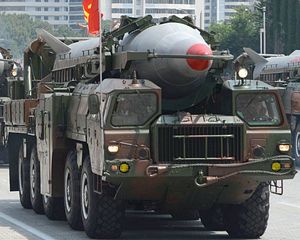North Korea’s test of a new intermediate-range ballistic missile (IRBM) on May 14 is important for the United States for two main reasons. First, it appears that Pyongyang is now capable of targeting Andersen Air Force Base on Guam in the Western Pacific with a ballistic missile, although it remains unclear how accurate the new Hwasong-12 IRBM is. Second, the Hwasong-12 launch — given that it possibly involved the test of an intercontinental ballistic missile subsystem (ICBM) — may prove to be a major stepping stone in the North Korean quest to threaten the U.S. mainland with nuclear weapons.
Indeed, it is the latter threat of an ICBM hitting a major U.S. city that for obvious reasons has been the primary concern of Washington policy makers ever since North Korea conducted its first nuclear test in 2006. Through sanctions and restrictions on technology transfers, the international community was so far only able to delay and increase costs for North Korea, but otherwise has failed to stop the country’s nuclear ambitions. Like hapless protagonists in ancient Greek myths who irrevocably meet their inevitable fate, the outcome in the current drama appears to be preordained and there is only speculation when rather than if North Korea will develop an ICBM capability, with estimates ranging from two to five years.
This is evident by only a cursory look at the North’s burgeoning nuclear store. Despite pressure and sanctions, North Korea was able to increase its stockpile of weapons-grade plutonium from 40 to approximately 50 kilograms over the last two years alone — enough to produce about ten nuclear warheads. North Korea also appears to have the capability to miniaturize the warheads and put them on short and medium-range ballistic missiles. Consequently, Pyongyang already appears capable of launching nuclear (and chemical) strikes against major cities in South Korea and Japan. (Given the assumed inaccuracy of its ballistic missiles, North Korea would likely launch the missiles in countervalue attacks against large population centers.)
The fact that North Korea can target Japan and South Korea and very soon the U.S. mainland has invoked the specter of ‘decoupling’, as my colleague Ankit Panda argued in a piece earlier this month. Decoupling — breaking the link between the United States and its allies — was one of former West German President Helmut Schmidt’s greatest fears during the Cold War. Schmidt was afraid that the United States would not risk its own destruction in the defense of its Western European allies in the event of nuclear war.
However, given the Trump administration’s bellicose rhetoric over preemptive strikes against North Korea intertwined with its ‘America First’ isolationist tendencies, Seoul and Tokyo may not only face decoupling, but also what one could call a ‘reverse decoupling’ problem. South Korea and Japan do not only fear that the United States will fail to come to the defense of its regional allies in the event of war, but they are simultaneously afraid that the Trump White House might recklessly instigate such a conflict given that the United States is least vulnerable to North Korean nuclear retaliation at the moment.
In other words, ‘reverse decoupling’ assumes that the United States can only militarily act against North Korea as long as the U.S. mainland is not targeted by a North Korean ICBM. In one sense, this is similar to what critics at the time pointed out about U.S. President Ronald Reagan’s Strategic Defense Initiative (SDI) in the 1980s: Given that it would presumably make the United States invulnerable to nuclear strikes, the SDI could force the Soviet Union to attack NATO preemptively.
Admittedly, this is not official U.S. policy vis-a-vis North Korea at the moment. Nevertheless, drawing a red line over North Korea’s deployment of nuclear-capable ICBMs not only makes U.S. preemptive strikes against the North more likely, but it could also force Pyongyang to put its nuclear weapons on hair trigger alert thereby increasing the chance that a nuclear missile is launched by mistake against South Korea or Japan.
To solve this reverse-decoupling problem, the United States would do well to start dealing with North Korea as if it was already in possession of an ICBM. First, it would deescalate the current situation by eliminating the ticking clock forcing the United States to come up with policy options (including preemptive strikes) prior to the deployment of nuclear-capable ICBMs. Second, it would also reduce the likelihood that any new ballistic missile launch testing ICBM components will turn into an international crisis. Third, it would assuage regional allies who may be afraid of a trigger-happy U.S. Commander-in-Chief.
The sooner the United States publicly accepts that a North Korean ICBM capability is a reality, the sooner Washington can move beyond dissecting the North’s military capabilities and focus on how to deal with the North Korean problem more comprehensively, moving beyond mere security. This does not mean that the United States should abandon its conventional and nuclear deterrence posture in East Asia. However, this would imply that, next to deterrence, dialogue has to assume more importance than it currently has.
Unless the United States is prepared to risk the lives of hundreds of thousands in East Asia as a result of preemptive military action, some form of a joint U.S.-China security guarantee to North Korea paired with a South Korean policy of re-engaging North Korea — much more difficult now than it was a decade ago — will be the only way forward. Accepting that North Korea will sooner or later field a nuclear-capable ICBM will perhaps help clarify what U.S. allies in the region already know: There are no good military options to solve the ongoing security crisis on the Korean Peninsula.

































